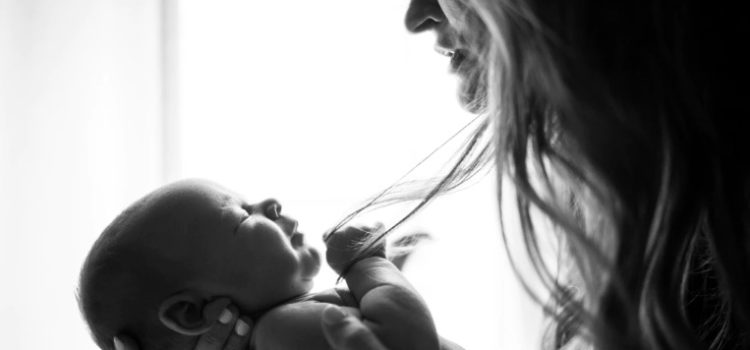

This article gives you a glimpse of what you can learn with Shortform. Shortform has the world’s best guides to 1000+ nonfiction books, plus other resources to help you accelerate your learning.
Want to learn faster and get smarter? Sign up for a free trial here .
Are you a new parent? What should you know about raising a child for the first time?
Parenting can be difficult at times, especially for first-time parents. Luckily, many books provide the best advice for new parents to make sure they’re equipped for the challenges that are coming their way.
Read below for essential tips that will make your parenting journey go smoother.
For New Moms: Remember You’re Not a Failure
When women become new mothers, it can be overwhelming. Caring for a newborn is exhausting; you’re navigating a world where your body has morphed and nursing is relentless.
It’s easy to feel bad about yourself because trying to keep up a perfect home, look great, keep your marriage together and be a perfect mother is daunting.
When you feel like you’re not succeeding as a new mom caring for an infant—something women think they should innately know how to do—it’s easy to feel like a failure.
In Girl, Wash Your Face, Rachel Hollis shares her experience as a new mother to help other women understand they’re not alone, and to offer the best advice for new parents.
Remember You’re Not Alone
Hollis suffered through awful pregnancies, including morning sickness that lasted for 9 months, varicose veins, and terrible anxiety over what could go wrong. When she had the baby, she was unprepared for how inadequate she felt. Her terror over what could go wrong was magnified. Breastfeeding was hard and the accompanying exhaustion was soul-sucking.
Her husband wasn’t helpful, leading her to feel she was doing it all by herself, which caused resentment and anger. She remembers once getting so angry with him that she shouted, “I never thought I could hate you as much as I hate you right now!”
As the baby got older, she was focused on housework, chores, and keeping up perfect appearances. She never simply enjoyed her time as a new mom; she didn’t feel connected to her child. This pattern kept up after the birth of her second child when she suffered from postpartum depression.
Her reality of motherhood didn’t match up to the images she saw in magazines and online, and she felt she was failing at the one thing she was supposed to be good at.
Advice to New Moms
Hollis learned important lessons she wants to share with new moms to save them some of the angst she went through. Hollis’ best advice for new parents is to understand that a new mother has two goals only: take care of the baby and take care of herself.
Everything else—laundry, cleaning, losing weight—doesn’t matter. You and your baby were meant to be a pair and you can’t fail at a job you were created to do. This doesn’t mean you won’t make mistakes and things will always be perfect, but you and your child are meant to be together. All the anxiety you feel about wanting to do everything right just shows that you’re concerned, dedicated, and focused. You’re already the best kind of parent!
Tips on Feeling Equipped to Be a New Mom
Follow this lifesaving advice Hollis suggests to survive as a new parent:
- Find a support group. Mommy and me classes, church groups, clubs— there are many places to find a group of women who understand what it’s like to be a new mom.
- Stay away from Instagram, TikTok, and Pinterest. Online images of motherhood perfection are likely to cause anxiety over what you think you lack. Take a break from social media in general.
- Get out of the house. There is a life beyond your messy nest, so get out every day and save your sanity.
- Talk about your feelings. Whether it’s your husband, a friend, or a family member, talking about what scares you or brings you anxiety is the best way to get rid of those negative feelings.
TITLE: Girl, Wash Your Face
AUTHOR: Rachel Hollis
TIME: 30
READS: 34.3
IMG_URL: https://www.shortform.com/blog/wp-content/uploads/2020/01/girlwashyourface_cover.jpg
BOOK_SUMMARYURL: girl-wash-your-face-summary-rachel-hollis
AMZN_ID: B072TMB75T
Potty Training
Once you understand the mindset you’ll need to succeed as a new parent, you can begin thinking about an important step in every child’s life: potty training. In Oh Crap! Potty Training, Jamie Glowacki provides the best parenting advice on when to start and how to prepare for potty training.
When to Begin
Glowacki recommends beginning potty training when your child is between 20 and 30 months old. She claims that at this age, your child will be eager to please, curious, and willing to accept new responsibilities. Any younger and they might not fully grasp what you expect of them. Any older and they’ll be more willing and able to resist you and engage in power struggles.
In addition, do not wait for your child to signal they are ready. Glowacki emphasizes that your child often won’t send these signals—they don’t know they want potty training, and will instead try and stay in their comfort zone (diapers). A toddler won’t make a large decision like when to start potty training on their own, so you have to.
Preparing
Glowacki provides several pieces of advice for new parents to follow to prepare themselves, their home, and their child for potty training.
1) Ensure consistent sleep: Before you plan potty training, ensure your child is on a consistent and healthy sleep schedule. If they’re tired, they’ll be less willing to learn and more irritable, making training far more difficult.
2) Get your partner on board: Make sure you and your partner are on the same page as you prepare and go through potty training. Disagreements between you will challenge your confidence and make potty training an unclear and inconsistent process.
3) Set a date: Set aside several days (ideally a week) for starting potty training. Make sure you have no plans during this period—you’ll need to constantly pay close attention to your child for the first few days so you can get them to the toilet as needed.
4) Buy a potty chair: Buy a potty chair for your child. A potty chair is less intimidating than a normal toilet and is also easier for them to access. Don’t put it out until you start potty training, so your child only sees and uses it as a toilet.
5) Explain the process: Explain to your child that they are no longer going to wear diapers and that you’re going to train them to use the toilet. This makes it clear what’s going to happen and what you need from them.
The Phases of Potty Training
After preparations are complete, Glowacki separates potty training into five phases, explaining what each phase looks like and how to approach them. Her advice for new parents emphasizes that there’s no one “correct” length for each phase—every child has their own pace.
Phase 1: Naked
During phase one, keep your child fully bottomless and focus entirely on them while they are awake. This way, you’ll immediately notice every time they start to pee or poop. Once they do, quickly bring them to a potty chair. These steps allow your child to consistently practice using the potty, and to make a connection between the potty and the act of peeing and pooping.
As phase one progresses, start to learn the signals your child gives when they need to pee or poop—this could include agitation, becoming quiet, or signs of physical discomfort. Also learn the general rhythm of when your child pees and poops each day. These signals and rhythms help you recognize when your child needs the potty so you can prompt them to go.
Glowacki notes that, throughout these phases, it’s okay to put diapers on your child while they sleep—training your child to use the potty during the day and at night right away puts a lot of stress on you and your child. However, explain that these diapers are only temporary until they’ve trained more. This keeps your process clear and consistent.
You’ll know it’s time for phase two when your child can pee and poop on the toilet while naked, whether you take them, prompt them, or they go by themselves. This usually happens between one and three days into potty training.
Phase 2: No Underwear
For phase two, dress your child in pants with no underwear. Glowacki explains that toddlers often have trouble understanding the difference between underwear and diapers, so avoiding underwear, for now, will mean fewer accidents.
Continue learning the rhythms and signals of your child’s bathroom use, prompting them to use the toilet when they show signals or when they usually need to go. You don’t need to focus entirely on your child during this phase and can start taking them on short outings like a walk around the block or a quick errand. Be prepared for your child to have accidents during phase two, keeping cleaning supplies on hand. Don’t get angry or upset with your child if they have an accident—they’re still learning. Instead, acknowledge they made a mistake without judging them: For example, say, “Pee goes in the potty,” and then have them help you clean up the accident.
You can move on to phase three when you’re confident in your child’s ability to go on longer outings without too many accidents. This is usually somewhere between two and nine days into potty training.
Phase 3: Outings
In phase three, take your child on longer trips to new places and situations like shopping or daycare. Bring your potty chair and towels or wipes for accidents, which are still likely to happen. Prompt your child to use the potty when you notice their signals and when you’d normally prompt even a potty-trained child: before leaving the house, before going to bed, or before starting an activity.
Glowacki suggests you progress into phase four when you feel your child is ready—things will likely get easier from here on out, so potty training will become less about specific steps and more about continuing your existing approach.
Phase 4: Underwear
Phase four has one simple step: putting your child back into underwear. By this phase of potty training, they’ll have been out of diapers long enough that they’ll no longer confuse underwear with diapers. In addition, an accident in underwear is far more noticeable and unpleasant than an accident in a diaper, which will encourage toilet use. That being said, Glowacki notes that your child may have trouble with this step, having accidents more frequently. If this is the case, you can have them go back to no underwear if needed—and don’t worry if your child needs to go without for a long time.
Phase 5: Independence
Phase five begins when your child can consistently self-initiate toilet use. Glowacki explains that this doesn’t mean you won’t have to prompt your child and won’t have any accidents, but it means these things are exceptions rather than inevitabilities—after all, children of all ages sometimes have accidents or need to be reminded to go pee. Phase five is your end goal, so make sure you pat yourself on the back for potty training your child.
[su_book__oh_crap!_potty_training]Discipline
Many parents, in a misguided effort to avoid damaging their child or wanting to be their child’s friend, avoid giving corrective feedback to their kids. These are the parents who let their kids curse at them in public or scream disruptively in movie theaters. These parents are teaching their kids the wrong boundaries of society, and in effect, they’re outsourcing the training to society. “Here’s my kid – society, please teach him the right rules.”
The problem is that society doesn’t care about your child nearly as much as you do. If you dislike your own child at times, imagine how other people will react. Other people will swiftly judge and punish your child mercilessly, with nowhere near the tolerance and patience that you have for your child. Here are examples of how a poorly socialized child will be rejected by society, as explained in Jordan Peterson’s 12 Rules for Life:
- In school, other children will refuse to spend time around a temperamental, unsociable child.
- Teachers will run out of patience and focus attention on more pleasant children, causing your child to fall behind.
- Parents will refuse your child’s presence at their playtimes.
- If these habits persist into adulthood, employers will fire them; relationship partners will reject them.
You are your child’s best shot at teaching society’s rules. Society doesn’t have the patience to teach your child—there are many other well-adjusted, functioning people to spend time on. A bad kid will simply be rejected and left behind.
And this problem can get worse throughout a child’s life. An early poor social experience can set up a vicious cycle of chronic maladjustment—a maladjusted child will act poorly; they will receive negative feedback from the world, often without understanding why; they will withdraw and feel rejected, causing anxiety, depression, and resentment. This further receives negative feedback from the world. This can last for a lifetime.
Shielding your child from corrective feedback is in effect crippling them in the long run. And early exposure matters—a child not taught to behave properly by age four will have lasting social difficulties. If you read the following discipline advice for new parents, your child will be well-socialized and will be able to take criticism well.
TITLE: 12 Rules for Life
AUTHOR: Jordan Peterson
TIME: 31
READS: 78
IMG_URL: https://www.shortform.com/blog/wp-content/uploads/2019/09/12rules_cover.jpg
BOOK_SUMMARYURL: 12-rules-for-life-summary-jordan-peterson
AMZN_ID: B01FPGY5T0
Strategies for Teaching Discipline
In No-Drama Discipline, Daniel J. Siegel and Tim Payne Bryson’s advice for new parents is to use these three strategies for teaching children how to behave appropriately and follow the rules:
Teaching Strategy 1: Start By Noticing, Not Criticizing
Instead of jumping straight to criticism when your child misbehaves, the authors recommend you start by describing what you see and asking your child to explain it to you. For example, if you see gum in your preschooler’s hair, you might say, “I see gum in your hair; how did that happen?” instead of yelling, “What did you do to your hair?!” This strategy directs children’s attention to their missteps without making them feel attacked.
Teaching Strategy 2: Create a Dialogue
In addition to asking kids to explain what happened or what they were feeling when they misbehaved, Siegel and Bryson advise asking them to help you come up with a solution. This gives their upper brains practice understanding the consequences of their behavior and coming up with solutions. They’ll also feel more respected throughout the process if they know you value their input—even if they don’t like your ultimate decision.
Teaching Strategy 3: Try a “Conditional Yes”
Another great piece of parenting advice is instead of responding with a hard “no” when your child asks for something, the authors recommend saying “yes”—but on your terms. For example, if your child wants to wear their astronaut costume to school, you might say, “Yes, you can wear your costume when you get home this afternoon” instead of an outright “no.” Hearing a flat “no” tends to activate children’s lower brains, so using a conditional yes instead can help avoid drama.
TITLE: No-Drama Discipline
AUTHOR: Daniel J. Siegel and Tina Payne Bryson
TIME: 10
READS: 47.3
IMG_URL: https://www.shortform.com/blog/wp-content/uploads/2021/11/no-drama-discipline-cover.png
BOOK_SUMMARYURL: no-drama-discipline-summary-daniel-j-siegel-and-tina-payne-bryson
AMZN_ID: XYZ
Connect With Your Child
Daniel J. Siegel and Tim Payne Bryson’s other parenting book The Whole-Brain Child emphasizes the importance of having an emotional and loving bond with your child. Their advice for new parents is to show your child how fun and rewarding it is to be in a relationship with you—their first and primary relationship—which will encourage them to build healthy relationships with other people, as well. When you have fun with your child, they get a burst of dopamine, a brain chemical that motivates them to repeat the experience; in this case, the dopamine makes them want to seek out strong, healthy bonds with others.
Additionally, encourage fun and healthy sibling relationships among your children. While it’s practically inevitable that siblings will fight, having fun together is the best predictor of a strong bond that will last into adulthood. As long as the fun outweighs the fighting, they’ll likely enjoy a close relationship as adults.
There are many ways to inject some fun into your daily family life, such as:
- Playing improv games. For example, have one person say the first sentence of a story, then go around the circle as each person takes turns adding the next sentence. These kinds of games help children learn to be receptive and flexible to changes.
- Initiating impromptu fort-building, water balloon fights, and other fun and unexpected activities
- Taking a family bike ride
- Giving your children a fun project to collaborate on, such as making a gift for a grandparent
This is not to say that play should replace boundaries and discipline, because structure is also essential for your child’s development. However, you can take a playful approach to parenting. When your child is upset—as long as you acknowledge and validate how she’s feeling—responding in a silly way can help your child get unstuck from that rim point. For example, if you’re bathing your daughter and she angrily insists that Dad washes her hair, instead of getting frustrated and explaining that dad is busy, try being silly and pretending to be Dad.
Tips for Using Connecting With Your Child at Different Ages
Tailor this great advice for new parents to your child’s age and developmental maturity with these tips.
Ages 0-3: Play with your child. Get on the ground with them, follow their lead, join them in playing with their toys, and tickle them.
Ages 3-6: Encourage your child to have fun with her siblings and relatives. Also, try using silliness to avoid power struggles and meltdowns.
Ages 6-9: Whether it’s a spontaneous water fight or a weekly movie night, incorporate fun into daily life. Dance, play, be silly, and make a point of creating opportunities to have fun and make happy memories.
Ages 9-12: As your child approaches adolescence, they may want to spend more time with their friends and less with you. However, if you consistently have fun with your child and maintain a strong connection, they’ll value the time they spend with you and want to continue enjoying time together, even as a teenager. Interactive games, sports, gardening, cooking, and day- or weekend-long trips are some of the many ways to bond and create treasured memories.
Make Sense of Your Childhood
Research shows that if you consistently respond to your child with empathy, they will thrive physically, emotionally, socially, and academically. However, one of the biggest factors determining the strength of your relationship with your child is how you’ve made sense of your relationship with your parents.
Your childhood experiences create the foundation for your life narrative, which is the story you create to make sense of who you are, how you feel about the past, why your parents (and other significant people) behaved a certain way, and how all of those factors shaped you. Just as implicit memories that haven’t been integrated can affect your present behavior without you realizing it, an unexamined childhood and lack of coherent narrative can have the same effect (in fact, implicit memories can play a role in this).
For example, if your father’s parents were cold and unsupportive, then he would’ve had to learn how to comfort himself as a child. Consequently, he likely took a similar approach to parenting you, telling you to suppress your feelings when you were sad or upset. If you don’t reflect on the wounds that produced your parents’ behavior and how their behavior affected you—through therapy, journaling, or talking with a friend or spouse—then you’re likely to repeat the pattern with your own child.
Siegel and Bryson’s advice for new parents who had a traumatic childhood is to examine their experiences and create a coherent life narrative, then determine how they want to raise their children. Rather than repeating the pattern or blindly doing the opposite, learn from your own childhood experiences and be deliberate about your approach to parenting. Even if you didn’t have a traumatic childhood, you might copy some of your parents’ traits that you despised as a child.
Don’t Coddle Your Child
Biologist E.O. Wilson said that the biggest threat to children’s development was the soccer mom. Wilson said that soccer moms repress children’s natural love of living things; they stop their kids from playing in the dirt, picking up insects, and so on.
However, according to the author of Antifragile Nassim Nicholas Taleb, the real problem with soccer moms is that they try to eliminate trial and error from their children’s lives. They make a map and demand that the kids follow it exactly, which might turn them into good students, but makes them unable to handle the ambiguity and changeability of real life.
The best kind of education is the one kids pursue themselves. Ideally, through browsing a library at home, picking out whatever topics interest them, and augmenting that with trial and error in the real world. Children are natural autodidacts—self-teachers—and that should be encouraged rather than repressed.
How to Create an Independent Child
In The Coddling of the American Mind, Greg Lukianoff and Jonathan Haidt introduce the concept of antifragility—that kids do not suffer from experiencing mild adversity; on the contrary, it makes them stronger. Overcoming difficulty is an essential part of the passage from childhood to adulthood. This is why the excessive focus on safety and efforts by parents to minimize risk, however well-intentioned, actually do great emotional harm to young people.
Because they are deprived of the opportunity to make mistakes, kids do not learn how to properly evaluate risks, gain independence, and navigate interpersonal conflicts without relying on a third-party authority figure, like a parent (or, later in life, a university official). Lukianoff and Haidt’s advice for new parents is to prepare children for independence, break emotional reasoning, and embrace nuance.
Prepare for Independence
Parents should give their children more opportunities to exercise their independence, even starting at an early age. This can be as simple as allowing them to enjoy more free and unsupervised play. When they notice conflicts arising among children during play, they should resist the temptation to intervene or make them “play fair.”
Parents would also be wise to periodically ask their kids what new challenges they want to take on. Even small milestones like walking to school or friends’ houses on their own can be remarkably self-affirming for kids. This also teaches them that “stranger danger” is an overhyped myth and that, if trouble arises, they should ask strangers for help.
Parents should pause, take a breath, and remember that the risk of abduction at the hands of strangers is practically zero and that crime, in general, is far lower than when they were children.
Break Emotional Reasoning
Parents also would do well to teach their kids not to rely on their emotions as their sole guide for interpreting reality. Even teaching children the basic principles behind cognitive behavioral therapy (CBT) can be beneficial.
CBT teaches people to break the vicious cycle of negative thinking by identifying and labeling untrue negative thoughts in order to foster more positive and realistic views of themselves. Parents can model this behavior by identifying and labeling their own negative thoughts to their children and showing them they’re irrational.
Parents can then use this as a launching pad for deeper discussions about the relationships between feelings and reality. For example, children often have a remarkable ability to understand difficult ideas through the use of metaphors and allegories. A parent might explain that reality can exist independently of one’s feelings by pointing out that even if someone feels that it’s snowing outside, they might be incorrect—it either is or isn’t snowing. One has to appreciate facts as well as feelings.
Embrace Nuance
The last piece of advice for new parents is that they should impress upon their children that no one is purely good or evil. All of us are complex beings with the capacity to do both good things and bad things based on our circumstances and our state of knowledge at a given time.
Black-and-white moral thinking can be highly damaging to a child’s emotional development. Even when children are wrong, parents should listen respectfully to their opinions and try to use reason to guide them toward more correct and accurate patterns of thought. This will teach a child that she is not a bad or immoral person simply because she is wrong about something or is in disagreement with someone.
This, in turn, will teach your child to apply this logic to others—that they are not bad simply for having different opinions. Your child will gain humility (because they will know that they, too, are capable of being wrong) and learn to give others the benefit of the doubt, instead of assuming the worst.
Does This Advice Work?
Even with the best advice for new parents, the parenting journey will still be difficult. There will be many sleepless nights, times when you’ll lose your patience, and moments when you’ll want to give up. But with helpful advice and countless tips, there’s reassurance that you’re not the only person who’s struggling.
If you’ve come across other great advice for new parents, leave it in the comments below.

Want to fast-track your learning? With Shortform, you’ll gain insights you won't find anywhere else .
Here's what you’ll get when you sign up for Shortform :
- Complicated ideas explained in simple and concise ways
- Smart analysis that connects what you’re reading to other key concepts
- Writing with zero fluff because we know how important your time is






